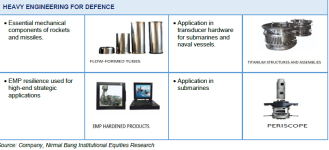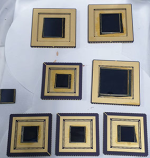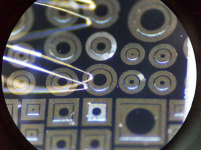Is this what it looks like when two screwdrivers join hands?𝗘𝗗𝗚𝗘 𝗮𝗻𝗱 𝗔𝗱𝗮𝗻𝗶 𝗗𝗲𝗳𝗲𝗻𝗰𝗲 & 𝗔𝗲𝗿𝗼𝘀𝗽𝗮𝗰𝗲 𝘀𝗶𝗴𝗻 𝗟𝗮𝗻𝗱𝗺𝗮𝗿𝗸 𝗖𝗼𝗼𝗽𝗲𝗿𝗮𝘁𝗶𝗼𝗻 𝗔𝗴𝗿𝗲𝗲𝗺𝗲𝗻𝘁 𝗶𝗻 𝗗𝗲𝗳𝗲𝗻𝗰𝗲 & 𝗦𝗲𝗰𝘂𝗿𝗶𝘁𝘆
EDGE, one of the world’s leading advanced technology and defence groups, has signed a milestone cooperation agreement with Adani Defence & Aerospace, one of the leading defence and aerospace companies of India.
The agreement aims to establish a global platform leveraging the defence and aerospace capabilities of both companies to bring together their respective product portfolios and cater to the requirements of global and local customers. This includes evaluating cooperation across EDGE’s and Adani’s core product domains, including missiles & weapons covering airborne, surface, infantry, ammunition, and air defence products, platforms &systems covering unmanned aerial systems (UAS), loitering munitions, counter drone systems, unmanned ground vehicles (UGV), as well as electronic warfare (EW) and cyber technologies.
The agreement will explore the establishment of R&D facilities in India and the UAE; the setting up of development, production and maintenance facilities of defence and aerospace solutions to not just serve the two captive markets, but also Southeast Asian and wider global markets.
You are using an out of date browser. It may not display this or other websites correctly.
You should upgrade or use an alternative browser.
You should upgrade or use an alternative browser.
Is this what it looks like when two screwdrivers join hands?
And the destruction of local industry continues. After Israeli now modis baap adani will rebrand uae maal.
ADE will shoot itself on UAVs, they dont need outside help. Adani already has access to Israeli technology. It's stupid to introduce another nonexistent design and complicate things.
And the destruction of local industry continues. After Israeli now modis baap adani will rebrand uae maal.
This is probably for guided ammunitions, which are already undergoing integration with LCA.
Can't give competition to something that doesn't exist, Archer NG at this stage exists only on paper no funding no prototype so it's nothing but a dream for now
And the destruction of local industry continues. After Israeli now modis baap adani will rebrand uae maal.
Another open tender by dalal army to procure foreign maal.
Want to become self reliant by giving contracts to dhandos. lol.
At this rate defence industry in India is not going any where.Want to become self reliant by giving contracts to dhandos. lol.
Shot by shot, Indian military is getting atmanirbhar
Last Updated: May 08, 2024, 07:40:00 PM IST
Synopsis
The government aims to increase India's annual defense production to nearly three times its current level, reaching Rs 3 lakh crore by 2028-29. Additionally, the target for defense exports is set to more than double, reaching Rs 50,000 crore compared to the current Rs 21,083 crore. For the fiscal year 2024-25, the goal is to achieve a total annual defense production worth Rs 1,75,000 crore, including exports valued at Rs 35,000 crore.
The government aims to increase India's annual defense production to nearly three times its current level, reaching Rs 3 lakh crore by 2028-29. Additionally, the target for defense exports is set to more than double, reaching Rs 50,000 crore compared to the current Rs 21,083 crore. For the fiscal year 2024-25, the goal is to achieve a total annual defense production worth Rs 1,75,000 crore, including exports valued at Rs 35,000 crore.

An Indian Army training exercise of Anti-Tank Guided Missile (ATGM) firing.
It's not the high-tech weapons such as the M-1 Abrams tank and F-16 fighter jets that can help Ukraine win the war against Russia. It's the humble artillery shells. Russia is currently firing around 10,000 shells a day, compared to just 2,000 a day from the Ukrainian side. Russia is producing about 250,000 artillery munitions per month, or about 3 million a year, while the US and Europe have the capacity to generate only about 1.2 million munitions annually to send to Ukraine, as per a recent CNN report.
Russia and Ukraine are now fighting a "production war", a senior NATO official has told CNN. Because the war is likely to be won with artillery shells instead of high-tech weapons.
India had foreseen a scenario like this a few years ago when it decided to indigenize its defence production at a large scale. Now it is close to achieving self-reliance in many items. In a significant feat, the army is aiming to stop import of all ammunition from the next financial year as the domestic industry has ramped up its capacity to meet all demands and is even poised to bag a chunk of the global market, a senior procurement officer has said.
How India is achieving defence atmanirbharta
Ammunition is not the only stuff India will soon start manufacturing entirely domestically. It is now producing even sophisticated weapons systems. India has so far indigenised 2,920 defence items out of 4,666 listed items, Director (DIP), Department of Defence Production, Amit Satija, said three months ago. These items include assemblies, sub-assemblies, raw materials, critical spares and components. Air Chief Marshal VR Chaudhari has said that the IAF has indigenised more than 60,000 components in the last two to three years.
The indigenisation of defence items was part of Prime Minister Narendra Modi's Make in India ambitious programme. In 2015, the government issued a record 56 licences, permitting players such as the Mahindras, Tatas and Pipavav to set up production units. In comparison, the previous government cleared just 47 projects in three years.
The previous United Progressive Alliance government had introduced an 'offsets policy' that required overseas companies winning Indian military contracts to invest at least 30 per cent of the contract value in the local defence or aerospace industry. However, most projects were stuck in permissions and other processes. In 2017, the government revised the policy to allow foreign companies more flexibility in choosing local partners and allocating work. The changes helped unlock $3.5 billion in foreign investments that were stuck due to the tough offset policy clauses.
Following its policy of Atmanirbhar Bharat, the government took the historic decision to convert the Ordnance Factory Board (OFB), a subordinate office of the Ministry of Defence, into seven new 100% government-owned corporate entities with professional management: Advanced Weapons and Equipment India Limited, Troop Comforts Ltd, Avani Armoured Vehicles, Munitions India Limited, India Optel Limited, Gliders India Limited, Yantra India Limited. Earlier, the 41 ordnance factories in the country came under the OFB and many were in losses and performing poorly. All of these seven new defence companies improved their performances and six of them reported provisional profits in their first six months of business.
In 2020, the Ministry of Defence (MoD) prepared a list of 101 items to be produced indigenously for which the imports would be banned. Last year, the ministry issued the fifth such positive indigenisation list of 98 military hardware. Earlier, four lists contained a total of 411 military items. Separately, the Department of Defence Production notified four positive indigenisation lists consisting of 4,666 items.
MSMEs and startups emerging as key partners
The Department of Defence is moving fast and steadily towards the indigenisation goal, with 40 to 50 licences being issued every year in defence production. Not just big private groups such as Tata and Adani are involved in defence production but the government has been encouraging MSMEs and startups too.
Many small players in India are designing and developing products and solutions for the defence sector. There has been a sharp growth in MSMEs and startups participating in this segment. As of December 2023, there were about 433 startups, MSMEs and individual innovators engaged in defence production in India, according to the Department of Defence Production and Ministry of Defence. The government has signed 302 contracts with them for various projects.
In 2018, Prime Minister Narendra Modi launched the Innovations for Defence Excellence (iDEX) framework to support innovation and create pathways for technology adoption. It has multiple programmes to identify and support startups with unique innovations.
The government aims to nearly triple India's total annual defence production to Rs 3 lakh crore by 2028-29. The target for defence exports is more than double at Rs 50,000 crore as against Rs 21,083 crore at present. The target for 2024-25 is Rs 1,75,000 crore worth of total annual defence production, which would include exports worth Rs 35,000 crore.
According to a report by Jefferies, with an estimated domestic defence opportunity ranging between USD 100-120 billion over the next 5-6 years, the sector anticipates a visible 13 per cent industry Compound Annual Growth Rate (CAGR) from FY23 to FY30.
Producing all of its ammunition domestically from the next financial year is a significant step for India's ambitious defence production programme. A steady pace of growth can build a military-industrial complex in India with its own Raytheons and Lockheed Martins.
Shot by shot, Indian military is getting atmanirbhar
We must hang corrupt generals and babus in public.
a bird in hand is worth two in bush. In the guise to building a ultimate war machines we have just become hostage to foreign suppliers.We must hang corrupt generals and babus in public.
USA is actively trying to destroy our indigenous industry. Seems like madarchod dalals have completely taken over MOD.
They tried to do the Javelin, 2-3 time over the last 10 years.USA is actively trying to destroy our indigenous industry. Seems like madarchod dalals have completely taken over MOD.
Why would this happen now? They will need to localize 2/3 to have any chance. That's a win for the indigenous industry; they had to go that far because of the maturity of Indian systems.
Kalyani/BDL already localised Spike-ER2. They are far ahead.
India successfully develops new explosive that can double lethality of warheads, bombs.
SEBEX 2 certified by Navy. Among most powerful conventional explosives in the world.
Thermobaric explosive that enhances firepower also certified.

SEBEX 2 certified by Navy. Among most powerful conventional explosives in the world.
Thermobaric explosive that enhances firepower also certified.












